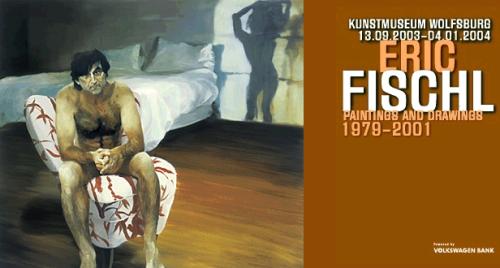Eric Fischl
dal 12/9/2003 al 4/1/2004
Segnalato da
12/9/2003
Eric Fischl
Kunstmuseum Wolfsburg, Wolfsburg
Paintings and drawings 1979-2001. The exhibition brings together approximately 40 paintings and an equal number of drawings. The selected works are divided into nine chapters, encompassing not only his voyeuristic and bizarre interiors and beach scenes but also his paintings from 1989 onwards - images inspired by his travels, self-portraits and the recently completed series The Bed, The Chair...

Paintings and drawings 1979-2001
In the nine years since it opened, the Kunstmuseum Wolfsburg has regularly
devoted solo exhibitions to personalities whose work has a strong impact
on young contemporary artists. One such figure is without doubt the
American painter Eric Fischl. Born in New York City in 1948, Fischl has
been one of the most influential artists of his generation since the late
1970s.
Although Eric Fischl's art has been shown extensively in Germany,
particularly during the 1980s, one seeks in vain paintings by him in
German museum collections. Nor has there been a retrospective of the
artist's work in this country up till now. The last major European
presentation was in 1991, at the Aarhus Art Museum and Louisiana Museum in
Denmark.
This exhibition has been made possible by the generous support of
Volkswagen Bank, Braunschweig. Volkswagen Bank has supported cultural
projects for the past 10 years and continues its cooperative involvement
with the Kunstmuseum Wolfsburg by sponsoring the Eric Fischl exhibition.
The exhibition concept devised by the Kunstmuseum Wolfsburg brings
together approximately 40 paintings and an equal number of drawings. The
selected works are divided into nine chapters, encompassing not only his
voyeuristic and bizarre interiors and beach scenes but also his paintings
from 1989 onwards - images inspired by his travels, self-portraits and the
recently completed series The Bed, The Chair...
Eric Fischl grew up in the suburban environment of Port Washington, Long
Island. In 1966 he started college, then moved to San Francisco and began
studying full-time in 1968 at the Arizona State University in Phoenix,
where his parents had settled. In that same year he discovered painting,
and in 1970 he finally enrolled at the California Institute of the Arts in
Valencia. In 1974 Fischl took up a teaching post at the Nova Scotia
College of Art and Design in Halifax, Canada. The paintings he made at
this time were abstract, however the results satisfied Fischl only up to a
point. He wanted to 'create meaning' and found the dogma of abstract
painting to be a limitation.
From 1979 onwards Fischl produced the works which were to provoke great
consternation on the American art scene, such as Bad Boy (1981), a risqué
and shocking bedroom scene where a young boy stares at the open crotch of
a naked woman, while at the same time he has his hand behind his back and
is fumbling in her handbag. Fischl went on to paint other scenes that
display a similarly strong sense of sexual ambiguity and enigmatic
narrative. Time and again he took the claustrophobic, self-righteous
aspects of American suburban life as his theme, later extending his
painterly explorations by devoting his attention extensively to the
creation of lustfully exhibitionist beach scenes.
Gijs van Tuyl describes the artist's work as follows: 'Fischl's paintings
and drawings tell the by no means heroic tales of representatives of
middle-class America, capturing these in allegorical depictions,
portraying the protagonists or representing them with figures from the
past. They are to a certain extent history paintings ex negative.'
Fischl uses many of his own photographs as the basis for his paintings.
The photograph is the starting point for a painterly process that led to
the particularly loose and lively touch of the pictures from recent years,
but which seldom allows one to completely forget the photographic image on
which it is based. His paintings, which frequently have erotic subject
matter, have on occasion been termed 'voyeuristic'; by placing figures in
the pictorial space they suggest narratives - comparable to a film still.
Fischl himself acknowledges the importance to him of images from the
media: 'I belong to a generation that grew up with film and television.
That is where my figurative sensibility comes from: making pictures stems
from making film.'
In the 1990s Fischl found new impetus for his art on journeys to India and
Rome, where he encountered the paintings of Manet and Caravaggio. New
themes came to the fore, such as a preoccupation with the foreign, with
age and death. Above all in his painterly treatment of light and shadow
his art reached a new high point. In the late 1990s Fischl also took great
interest in portrait painting for the first time. Here, too, he drew upon
photographic source images.
Between 1999 and 2001 he completed the 15 paintings that make up the
series The Bed, The Chair..., the most recent group of works in the
exhibition. Here, Fischl employs a complex montage technique whereby he
creates different constellations of meaning by combining a small number of
recurring objects with selected new elements. Again based on photographic
source images, Fischl stages an intimate play by arranging people and
furniture in a stage-like bedroom setting, using a number of different
protagonists and conveying cryptic messages. With this series the
exhibition circles back to the paintings from the late 70s and early 80s.
A catalogue is being published by Hatje Cantz Verlag to accompany the
exhibition 'Eric Fischl: Paintings and Drawings 1979-2001', approx. 144
pages with around 70 full-page colour plates, a preface by Gijs van Tuyl,
a conversation between Eric Fischl and Frederic Tuten along with essays by
Carolin Bohlmann, Jörg Garbrecht, Victoria von Flemming, Annelie Lütgens
and Peter Schjeldahl.
Exhibition hours:
Tuesday 11 a.m. - 8 p.m.
Wednesday - Sunday 11 a.m. - 6 p.m.
Closed on Mondays
Kunstmuseum Wolfsburg
Porschestrasse 53
38440 Wolfsburg Germany
Phone: +49.5361.26690
Fax: +49.5361.266966



